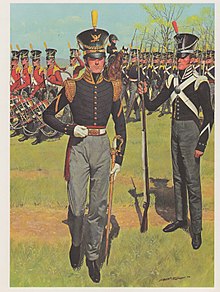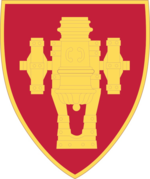|
United States Army Field Artillery School
The United States Army Field Artillery School (USAFAS) trains Field Artillery Soldiers and Marines in tactics, techniques, and procedures for the employment of fire support systems in support of the maneuver commander. The school further develops leaders who are tactically and technically proficient, develops and refines warfighting doctrine, and designs units capable of winning on future battlefields. The school is currently located at Fort Sill, Oklahoma. VisionBe the world's premier Field Artillery force; modernized, organized, trained, and ready to integrate and employ Army, Joint and Multinational fires across multiple domains enabling victory through Unified Land Operations. Mission
EndstateThe U.S. Army Field Artillery enables maneuver commanders to dominate in Unified Land Operations through effective targeting, integration and delivery of fires. HeraldryDeviceShield: Gules, a field piece of the 16th century paleways in plan Or. Crest: On a wreath of the colors (Or and Gules) the arm of Saint Barbara embowed clothed of the second, issuing from the upper portion of an embattled tower Argent, and grasping flashes of lightning Proper. Motto: CEDAT FORTUNA PERITIS (Let Fortune Yield to Experience, or Skill is Better than Luck). Symbolism:The shield is red for Artillery; the field piece depicted, having been used in the 16th century, is the forerunner of the modern artillery. The crest is the arm of Saint Barbara, the patron saint of Artillery, holding flashes of lightning alluding to the pagan idea of Jove's ability to destroy with his bolts that which offended him. Background: The device was originally approved for The Field Artillery School on 8 April 1926. It was redesignated for The Artillery School on 19 May 1954. On 11 September 1957 the device was redesignated for the U.S. Artillery and Missile School. On 13 February 1969 it was redesignated for the U.S. Field Artillery School.[2] Shoulder sleeve insigniaDescription/Blazon: On a scarlet shield edged with a 1⁄8 inch (0.32 cm) yellow border, 3 inches (7.6 cm) in height and 2 inches (5.1 cm) in width overall, a yellow field piece. Symbolism: The ancient field piece is taken from the device of the Field Artillery School, as well as the colors scarlet and yellow which are for Artillery. Background: The shoulder sleeve insignia was originally approved on 17 July 1970 for the U.S. Army Field Artillery School. It was amended on 9 June 1981 to extend authorization for wear to include personnel assigned to the U.S. Army Field Artillery Center. (TIOH Dwg. No. A-1-188)[2] Distinctive unit insigniaDescription/Blazon: A gold color metal and enamel device 1 inch (2.5 cm) in height overall on a shield Gules, a field piece of the 16th century paleways in plan Or. Symbolism: The shield is red for Artillery; the field piece depicted, having been used in the 16th century, is the forerunner of the modern artillery. Background: The distinctive unit insignia was originally approved for the Field Artillery School on 29 March 1930. It was redesignated for the Artillery School on 19 May 1954. On 11 September 1957 the insignia was redesignated for the U.S. Army Artillery and Missile School. The distinctive unit insignia was redesignated for the U.S. Field Army Artillery School on 13 February 1969. It was amended on 9 June 1981 to extend authorization for wear to personnel assigned to the U.S. Army Field Artillery Center.[2] History The origin of USAFAS can be traced back to the 1907 reorganization of the Artillery Corps and to the character of Fort Sill at that time. The 1907 reorganization created Coast and Field Artillery Branches. In the process of this reorganization, the Field Artillery was deprived of its former home at Fort Monroe, Virginia. Fort Sill was considered the best location for a Field Artillery school, since its 15,000-acre (61 km2) reservation allowed ample room for target practice and its great variety of terrain offered an excellent area for different types of tactical training. In addition, the post had already assumed the character of the home of artillery with a large number of artillery units assigned. The first artillery school, the US Army School of Fire, was organized in 1911 by Captain Dan Tyler Moore. With the exception of a brief period in 1916 when school troops were used as frontier security guards during the Mexican Revolution, the School has operated and expanded continuously. Hundreds of thousands of artillerymen have been trained at Fort Sill since the inception of the School. After the United States entered World War I, the school reopened in 1917 with Col. William J. Snow as commandant. The Field Artillery School, as it was now known, added more courses. After the war, school commandants began a long-range program to improve field artillery mobility, gunnery and equipment. Budget cuts during the 1920s hampered their efforts, but innovative directors of the Gunnery Department, with support from school commandants, helped modernize the field artillery in the 1930s. Maj. Carlos Brewer, director of the Gunnery Department in the late 1920s and early 1930s, introduced new fire direction techniques so fire support would be more responsive. Maj. Orlando Ward, the next department director, developed the fire direction center to centralize command and control and to facilitate massing fire. Brewer, Ward, and Lt. Col. H.L.C. Jones encouraged replacing horses with motor vehicles for moving field artillery guns. During World War II, to best use new long-range guns and better response times, the Field Artillery School championed the use of air observation to control artillery fires. The War Department approved organic field artillery air observation in 1942. The artillery air observers adjusted massed fire and performed liaison, reconnaissance, and other missions during the war. Following the war, the school adapted to the atomic age and the Cold War. The War Department consolidated all artillery training and developments under the U.S. Army Artillery Center at Fort Sill in 1946. At that time, the center included the Artillery School, the Antiaircraft and Guided Missile School at Fort Bliss, Texas, and the Coast Artillery School at Fort Scott, Calif. The air defense artillery became its own branch in 1968. In 1953, school personnel fired the first nuclear-capable fieldartillery gun (the 280mm gun known as Atomic Annie) at Frenchman's Flat, Nevada. During the 1950s, school personnel also helped develop rocket and missile warfare (The U.S. arsenal included the Honest John rocket, Corporal missile and Redstone missile) that could carry a nuclear warhead. In 1963, the school tested aerial rocket artillery, which equipped helicopters with rockets. As demonstrated in the Vietnam War, aerial rocket artillery was effective. The school cooperated in the development of the Field Artillery Digital Automated Computer, commonly called FADAC, to compute fire direction data. Introduced in 1966–67, FADAC made the field artillery a leader in computer developments for the Army. After the Vietnam War, the school participated in the introduction of the Multiple-Launch Rocket System, the Army Tactical Missile System, the Paladin 155-mm. self-propelled howitzer, and other field artillery systems. The field artillery's performance in military operations in Operation Desert Storm in 1990-91 and Iraq and Afghanistan from 2001 to today validated the school's modernization efforts. Field artillery officers and soldiers can do complicated logarithmic calculations to fire a mission in one moment or they can escort a supply convoy, secure prisoners, patrol a village or any other mission the next.[3] CommandantsCommandants of the Artillery School include John Patten Story, who commanded from 1902 to 1904.[4] Other commandants have included:[5]
See alsoReferences
Further reading
|
||||||||||||||||||||||||



